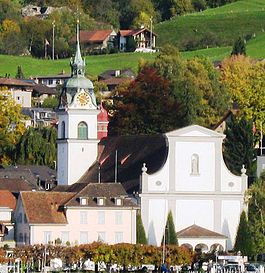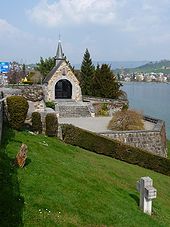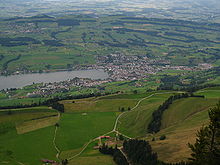- Küssnacht
-
For the similar named municipality in Zürich, see Küsnacht.
Küssnacht Country Switzerland 
Canton Schwyz District Küssnacht 47°4′N 8°26′E / 47.067°N 8.433°ECoordinates: 47°4′N 8°26′E / 47.067°N 8.433°E Population 12,139 (Dec 2009)[1] - Density 335 /km2 (869 /sq mi) Area 36.20 km2 (13.98 sq mi) Elevation 442 m (1,450 ft) Postal code 6403 SFOS number 1331 Mayor Hans Kathriner Surrounded by Greppen, Meggen, Adligenswil, Udligenswil, Meierskappel, Risch, Walchwil and Arth Twin towns Küssaberg (Germany), Zduny (Poland) Website www.kuessnacht.ch
SFSO statisticsView map of Küssnacht Küssnacht am Rigi (official name since 2004: Küssnacht) is a district and municipality in the canton of Schwyz in Switzerland, consisting of three villages: Küssnacht, Immensee and Merlischachen. It is situated at the north shore of Lake Lucerne and at the south shore of Lake Zug below mount Rigi (1,797 m (5,896 ft)).
Contents
History
Küssnacht is first mentioned around 840 as in Chussenacho though this is from an 11th Century copy of the original document. In 1179 it was mentioned as Chussenacho.[2]
In 1424 Küssnacht became a district of the Canton of Schwyz.
According to the legend of Wilhelm Tell, the hero shot the Austrian bailiff Gessler at the Hohle Gasse near the Gesslerburg with his crossbow.
Here through this deep defile he needs must pass; there leads no other road to Küssnacht.On August 29, 1935, Queen Astrid of the Belgians was killed here in a road accident. A memorial chapel ("Königin-Astrid-Kapelle") was built at the accident scene.
The well known Klausjagen ("Nicholas chase") festival takes place in Küssnacht every year on the eve of St. Nicholas Day (December 5). The festival, attended by about 20,000 people, consists of a parade of around 1,000 participants, and lasts far into the night.
Geography
Küssnacht viewed from Rigi Kulm
Küssnacht has an area, as of 2006[update], of 29.5 km2 (11.4 sq mi). Of this area, 57.5% is used for agricultural purposes, while 27% is forested. Of the rest of the land, 14.1% is settled (buildings or roads) and the remainder (1.4%) is non-productive (rivers, glaciers or mountains).[3]
The municipality is at the foot the Rigi mountain between the Lake of Lucerne and Lake Zug. It consists of the villages of Küssnacht, Immensee and Merlischachen as well as the hamlets of Haltikon and Seebodenalp.
It is the capital and only municipality of the district of Küssnacht.
Demographics
Küssnacht has a population (as of 31 December 2009) of 12,139.[1] As of 2007[update], 19.1% of the population was made up of foreign nationals.[4] Over the last 10 years the population has grown at a rate of 11.5%. Most of the population (as of 2000[update]) speaks German (87.5%), with Albanian being second most common ( 2.7%) and Serbo-Croatian being third ( 2.7%).[3]
As of 2000[update] the gender distribution of the population was 50.5% male and 49.5% female. The age distribution, as of 2008[update], in Küssnacht is; 2,707 people or 25.3% of the population is between 0 and 19. 3,168 people or 29.6% are 20 to 39, and 3,406 people or 31.8% are 40 to 64. The senior population distribution is 775 people or 7.2% are 65 to 74. There are 477 people or 4.5% who are 70 to 79 and 171 people or 1.60% of the population who are over 80. There are 3 people who are over 100 years old in Küssnacht.[4]
As of 2000[update] there are 4,377 households, of which 1,387 households (or about 31.7%) contain only a single individual. 271 or about 6.2% are large households, with at least five members.[4]
In the 2007 election the most popular party was the SVP which received 36.3% of the vote. The next three most popular parties were the CVP (25.6%), the FDP (21.6%) and the SPS (12.1%).[3]
The entire Swiss population is generally well educated. In Küssnacht about 72.9% of the population (between age 25-64) have completed either non-mandatory upper secondary education or additional higher education (either university or a Fachhochschule).[3]
Küssnacht has an unemployment rate of 1.62%. As of 2005[update], there were 344 people employed in the primary economic sector and about 125 businesses involved in this sector. 2,340 people are employed in the secondary sector and there are 153 businesses in this sector. 3,135 people are employed in the tertiary sector, with 486 businesses in this sector.[3]
From the 2000 census[update], 7,891 or 73.7% are Roman Catholic, while 1,152 or 10.8% belonged to the Swiss Reformed Church. Of the rest of the population, there are less than 5 individuals who belong to the Christian Catholic faith, there are 146 individuals (or about 1.36% of the population) who belong to the Orthodox Church, and there are 17 individuals (or about 0.16% of the population) who belong to another Christian church. There are less than 5 individuals who are Jewish, and 501 (or about 4.68% of the population) who are Islamic. There are 76 individuals (or about 0.71% of the population) who belong to another church (not listed on the census), 563 (or about 5.26% of the population) belong to no church, are agnostic or atheist, and 354 individuals (or about 3.31% of the population) did not answer the question.[4]
The historical population is given in the following table:[2]
year population 1743 1,506 1799 1,987 1850 2,788 1900 3,562 1950 5,680 1970 7,956 1980 8,203 1985 8,676 1990 9,437 2000 10,908 2005 11,639 2007 11,870 References
- ^ a b Swiss Federal Statistical Office, MS Excel document – Bilanz der ständigen Wohnbevölkerung nach Kantonen, Bezirken und Gemeinden (German) accessed 25 August 2010
- ^ a b Küssnacht in German, French and Italian in the online Historical Dictionary of Switzerland.
- ^ a b c d e Swiss Federal Statistical Office accessed 31-Aug-2009
- ^ a b c d Canton Schwyz Statistics (German) accessed 27 August 2009
External links
- Official webpage
- Tourist webpage
- Future plans of Küssnacht
- Hohle Gasse
- Klausjagen
- VR panorama of King Albert II visiting the Astrid Chapel in Küssnacht am Rigi
Districts of Switzerland · Municipalities of the canton of SchwyzCategories:- Municipalities of the canton of Schwyz
- Municipalities of Switzerland
- Cities in Switzerland
- Districts of the canton of Schwyz
Wikimedia Foundation. 2010.





